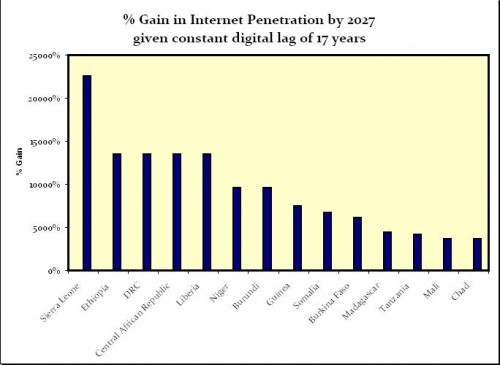For how long can Africa’s 17 year ‘digital lag’ remain constant?

% Gain in Internet Penetration by 2027 given constant UNCTAD 'digital lag' of 17 years. Click to enlarge.
The 2010 Information Economy Report from the UN Conference on Trade and Development (UNCTAD) recently found that:
Even with current high growth rates, our calculations show that it will be 2019 before the poorest countries achieve the internet usage rates reached by the richest countries in 2002. That’s a ‘digital lag’ of 17 years so governments and private firms must work together to improve access.”
In addition, a professor at the University of Manchester who was greatly involved with the study commented on the challenges and potential growth of the Internet in these African markets. The excitement surrounding broadband and the potential for vast increases in connectivity are great, but what will happen to the lag after 2019, the year cited as a benchmark in the report?
A quick look at Internet World Stats data suggests the lag will only increase for the least-connected African nations. Currently, Europe averages 58.4% Internet penetration, whereas North America witnesses 77.4% of the population online. Using 68% penetration as a loose approximation of Internet usage rates for the richest countries in 2010, we can calculate the percentage gains needed by the less-connected African nations to reach 68% penetration in the year 2027:
Country 2010 Internet Penetration % Gain needed to maintain 17 yr lag
Sierra Leone 0.30% 22567%
Ethiopia 0.50% 13500%
DRC 0.50% 13500%
Central African Republic 0.50% 13500%
Liberia 0.50% 13500%
Niger 0.70% 9614%
Burundi 0.70% 9614%
Guinea 0.90% 7456%
Somalia 1.00% 6700%
Burkina Faso 1.10% 6082%
Madagascar 1.50% 4433%
Tanzania 1.60% 4150%
Mali 1.80% 3678%
Chad 1.80% 3678%
Will any of these nations connect an additional 10,000 people to the Internet for every citizen who currently has access in 2010? Possibly, if the explosive growth so typical of Africa’s mobile industry is allowed by local markets. However, the challenge will be finding support from the respective governments, procuring interest from the populace, and creating infrastructure in areas lacking electricity.












 Twitter
Twitter Facebook
Facebook Pinterest
Pinterest